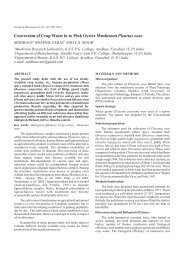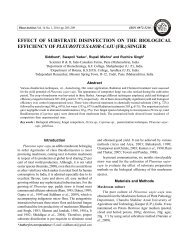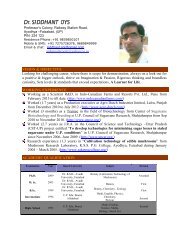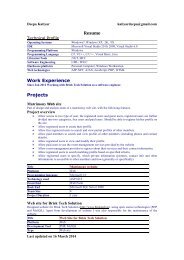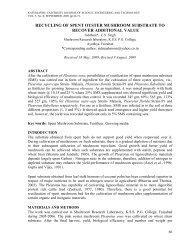Spawn and Spawning Strategies for the Cultivation of Pleurotus eous (Berkeley) Saccardo
Create successful ePaper yourself
Turn your PDF publications into a flip-book with our unique Google optimized e-Paper software.
INTERNATIONAL JOURNAL OF PHARMACEUTICAL AND CHEMICAL SCIENCES<br />
ISSN: 22775005<br />
Research Article<br />
<strong>Spawn</strong> <strong>and</strong> <strong>Spawn</strong>ing <strong>Strategies</strong> <strong>for</strong> <strong>the</strong> <strong>Cultivation</strong> <strong>of</strong><br />
<strong>Pleurotus</strong> <strong>eous</strong> (<strong>Berkeley</strong>) <strong>Saccardo</strong><br />
Siddhant 1* , Swapnil Yadav 2 <strong>and</strong> CS. Singh 3<br />
1 Mushroom Research Laboratory, K.S.S. P.G. College, Ayodhya- Faizabad, Uttar Pradesh,<br />
India.<br />
2 Department <strong>of</strong> Biotechnology, G.F. College, Shahjahanpur, Uttar Pradesh, India<br />
3 Department <strong>of</strong> Botany, K.S.S. P.G. College, Ayodhya- Faizabad, Uttar Pradesh, India.<br />
ABSTRACT<br />
In present study, spawn developed on different cereals, viz., Barley (Hordeum vulgare), Maize (Zea<br />
mays), Oat (Avena sativa); millets, viz., Italian millet (Setaria italica), Pearl millet (Pennisetum<br />
typhoides), Little millet (Panicum miliare) Sorghum (Sorghum vulgaris) <strong>and</strong> agricultural wastes like<br />
wheat straw, sugarcane bagasse, rice husk, mango saw dust <strong>and</strong> hulled corn cob were assessed against<br />
wheat grain spawn (Triticum aestivum) <strong>for</strong> enhancing yield <strong>and</strong> biological efficiency <strong>of</strong> <strong>Pleurotus</strong><br />
<strong>eous</strong>. Three spawning techniques, viz., top, thorough <strong>and</strong> layer spawning were also evaluated in this<br />
study. The spawn developed on oat <strong>and</strong> barley grains were found most productive while hulled corn<br />
cob proved best alternative <strong>of</strong> grain substrate with 340 gm, 68% <strong>and</strong> 339 gm, 67.8% <strong>and</strong> 330 gm, 66.0<br />
% yield <strong>and</strong> biological efficiency respectively. All <strong>the</strong> spawning techniques gave similar response<br />
though <strong>the</strong>ir magnitude varied among <strong>the</strong>mselves.<br />
Keywords: Biological efficiency, Grain spawn, <strong>and</strong> agro-waste spawn, <strong>Spawn</strong>ing technique.<br />
INTRODUCTION<br />
Mushroom is an unique horticultural crop. In<br />
contrast to <strong>the</strong> cultivation <strong>of</strong> higher plants,<br />
which started in pre-historical times, <strong>the</strong><br />
culture <strong>of</strong> fungi is relatively <strong>of</strong> recent<br />
innovation. Historically, mushrooms were<br />
ga<strong>the</strong>red from <strong>the</strong> wild <strong>for</strong> consumption <strong>and</strong> <strong>for</strong><br />
medicinal use. The first commercial cultivation<br />
<strong>of</strong> edible mushrooms was developed in France<br />
in <strong>the</strong> 18th century since <strong>the</strong>n it has traveled<br />
far a head. Over 200 species <strong>of</strong> mushrooms<br />
have been collected from <strong>the</strong> wild <strong>and</strong> utilized<br />
<strong>for</strong> various traditional <strong>and</strong> medical purposes<br />
mostly in <strong>the</strong> Far East. Till date, about 35<br />
mushroom species have been cultivated<br />
commercially. Of <strong>the</strong>se, about 20 are<br />
cultivated on industrial scale throughout <strong>the</strong><br />
world due to <strong>the</strong>ir high nutritive <strong>and</strong> medicinal<br />
value which contributes to a healthy diet with<br />
rich source <strong>of</strong> vitamins, minerals <strong>and</strong> proteins<br />
(Garcha et.al., 1993). The spawn <strong>and</strong> spawn<br />
making has been primary concern in<br />
mushroom cultivation which is achieved by<br />
developing mushroom mycelia on supporting<br />
medium under controlled environmental<br />
conditions. In almost all cases <strong>the</strong> supporting<br />
matrix is sterilized grain which is preferred due<br />
to its bio-chemical properties <strong>and</strong> practical<br />
per<strong>for</strong>mance over o<strong>the</strong>rs. Un<strong>for</strong>tunately, <strong>the</strong><br />
ever increasing dem<strong>and</strong> <strong>of</strong> food grains <strong>for</strong><br />
human consumption leaves little scope <strong>for</strong><br />
<strong>the</strong>ir use in spawn making. A number <strong>of</strong> o<strong>the</strong>r<br />
materials, mostly agricultural wastes, can be<br />
used to prepare mushroom spawn. The types<br />
<strong>of</strong> waste available varies from region to region.<br />
As spawn making, substrate inoculation is also<br />
a crucial phase in mushroom growing<br />
practices.<br />
<strong>Pleurotus</strong> <strong>eous</strong>, a pink oyster mushroom,<br />
belonging to family Tricholomataceae <strong>of</strong> order<br />
Agaricales is less documented than o<strong>the</strong>r<br />
oyster species. There<strong>for</strong>e, <strong>the</strong>re is a vast<br />
scope <strong>of</strong> study on its cultivation. Aiming at <strong>the</strong><br />
above, different attempts regarding to spawn<br />
<strong>and</strong> spawning techniques were made to find<br />
out <strong>the</strong>ir efficiency <strong>for</strong> <strong>the</strong> better production <strong>of</strong><br />
this mushroom species.<br />
MATERIALS AND METHODS<br />
Micro-organism<br />
The pure culture <strong>of</strong> <strong>Pleurotus</strong> <strong>eous</strong> (Berk)<br />
Sacc. was obtained from <strong>the</strong> mushroom<br />
section <strong>of</strong> Plant Pathology Department,<br />
Ch<strong>and</strong>ra Shekhar Azad University <strong>of</strong><br />
Agriculture <strong>and</strong> Technology, Kanpur (U.P.)<br />
India. The culture was maintained <strong>and</strong><br />
subcultured on potato dextrose agar (PDA)<br />
medium.<br />
<strong>Spawn</strong> preparation<br />
Various cereals, viz., wheat grains (Triticum<br />
aestivum), Barley (Hordeum vulgare), Maize<br />
(Zea mays), Oat (Avena sativa) <strong>and</strong> millets,<br />
viz., Italian millet (Setaria italica), Pearl millet<br />
Vol. 2 (3) Jul-Sep 2013 www.ijpcsonline.com 1494
INTERNATIONAL JOURNAL OF PHARMACEUTICAL AND CHEMICAL SCIENCES<br />
ISSN: 22775005<br />
(Pennisetum typhoides), Little millet (Panicum<br />
miliare) Sorghum (Sorghum vulgaris) were<br />
utilized as grain substrate <strong>for</strong> planting spawn.<br />
These were purchased from <strong>the</strong> seed market<br />
<strong>of</strong> Faizabad. Some locally available<br />
agricultural wastes like wheat straw,<br />
sugarcane bagasse, rice husk, mango saw<br />
dust <strong>and</strong> hulled corn cob were also utilized <strong>for</strong><br />
this purpose. The mo<strong>the</strong>r spawn was prepared<br />
on traditionally used wheat grains (Triticum<br />
aestivum).<br />
The spawns were prepared by following <strong>the</strong><br />
st<strong>and</strong>ard method. The planting spawn,<br />
developed on wheat grains was later treated<br />
as control.<br />
Substrate preparation<br />
The substrate used <strong>for</strong> cultivation <strong>of</strong> <strong>Pleurotus</strong><br />
<strong>eous</strong> was wheat straw which had been<br />
recommended as best substrate <strong>for</strong> mushroom<br />
cultivation (Singh <strong>and</strong> Singh, 1994). It was<br />
filled (500 gm) in polypropylene bags (42×30<br />
cm size) <strong>and</strong> <strong>the</strong>n washed separately in fresh<br />
water <strong>and</strong> <strong>the</strong>n pasteurized in <strong>the</strong> solution <strong>of</strong><br />
Formaldehyde (500ppm) <strong>and</strong> Bavistin (75ppm)<br />
<strong>for</strong> 18 hours as recommended by Vijay <strong>and</strong><br />
Sohi (1987).<br />
<strong>Spawn</strong> dose<br />
Inoculation <strong>of</strong> substrate was made with<br />
planting spawn <strong>of</strong> P. <strong>eous</strong> @ 5% w/w on dry<br />
weight basis under aseptic conditions.<br />
<strong>Spawn</strong>ing techniques<br />
Three methods <strong>of</strong> spawning were employed<br />
<strong>for</strong> substrate inoculation.<br />
a) Top spawning<br />
In this method, spawn was planted just above<br />
<strong>the</strong> surface <strong>of</strong> substrate. It was <strong>the</strong>n covered<br />
by a thin layer <strong>of</strong> substrate.<br />
b) Thorough spawning<br />
It was achieved by thoroughly mixing <strong>of</strong><br />
spawn with <strong>the</strong> substrate while filling <strong>the</strong> bags.<br />
c) Layer spawning<br />
The spawn was planted in <strong>the</strong> substrate in<br />
multilayered (3) manner. This mode <strong>of</strong><br />
spawning was later treated as control <strong>and</strong><br />
uni<strong>for</strong>mly used in all <strong>the</strong> experiments.<br />
Method <strong>of</strong> cultivation<br />
Plastic bag technology was used in this<br />
experiment. The beds were prepared from<br />
pasteurized substrate following <strong>the</strong> procedure<br />
adopted by Bano (1971). These were<br />
incubated in cultivation room at 22-30°C<br />
temperature <strong>for</strong> spawn run. When mycelia had<br />
completely covered <strong>the</strong> beds, <strong>the</strong> poly<strong>the</strong>ne<br />
covering were turned <strong>of</strong>f <strong>and</strong> relative humidity<br />
was maintained 85-95 per cent with <strong>the</strong> help <strong>of</strong><br />
humidifier.<br />
Presentation <strong>of</strong> data <strong>and</strong> evaluation <strong>of</strong><br />
biological efficiency <strong>of</strong> mushroom<br />
The data recorded in respect <strong>of</strong> yield<br />
parameters were time lapsed in spawn run, pin<br />
head initiation <strong>and</strong> maturity <strong>of</strong> fruit bodies,<br />
number <strong>of</strong> flushes, total yield, number <strong>and</strong><br />
weight per sporocarp on different kinds <strong>of</strong><br />
spawn <strong>and</strong> spawning techniques. The<br />
biological efficiency <strong>of</strong> mushroom was worked<br />
out as percentage yield <strong>of</strong> fresh mushroom in<br />
relation to dry weight <strong>of</strong> <strong>the</strong> substrate as<br />
suggested by Chang <strong>and</strong> Miles (1989).<br />
Yield <strong>of</strong> fresh mushroom (gm)<br />
Biological efficiency = ------------------------------------------------------- ×100<br />
Total weight <strong>of</strong> dry substrate used (gm)<br />
Statistical analysis<br />
Completely R<strong>and</strong>omized Design (CRD) was<br />
employed <strong>for</strong> all <strong>the</strong> experiments. All <strong>the</strong> data<br />
were statistically analysed. The critical<br />
difference (CD) was worked out at five per<br />
cent probability level.<br />
RESULTS AND DISCUSSION<br />
The results regarding various parameter <strong>of</strong><br />
mushroom production are presented in Tables<br />
1-3.<br />
Effect <strong>of</strong> grain spawn on cultivation <strong>of</strong><br />
<strong>Pleurotus</strong> <strong>eous</strong><br />
The spawn was developed on different kinds<br />
<strong>of</strong> cereals <strong>and</strong> millets. The grain substrates<br />
were inoculated with mo<strong>the</strong>r spawn <strong>of</strong><br />
mushroom <strong>and</strong> incubated <strong>for</strong> mycelial run. The<br />
incubation period varied among <strong>the</strong>mselves<br />
which ranged 13-16 days (Table.1). For <strong>the</strong><br />
spawn development, Oat <strong>and</strong> barley grains<br />
registered least incubation time (13 days each)<br />
which was equal to control while long spawn<br />
run period was noted <strong>for</strong> Italian <strong>and</strong> little<br />
millets (16 days). Once spawn was prepared,<br />
it was planted in to <strong>the</strong> substrate where <strong>the</strong>y<br />
showed variable effect on duration <strong>of</strong> spawn<br />
run, primordial initiation <strong>and</strong> fruit body<br />
maturation which ranged from 13-18 days, 16-<br />
22 days <strong>and</strong> 20-26 days, respectively. A faster<br />
rate <strong>of</strong> cropping was noted in Italian <strong>and</strong> little<br />
Vol. 2 (3) Jul-Sep 2013 www.ijpcsonline.com 1495
INTERNATIONAL JOURNAL OF PHARMACEUTICAL AND CHEMICAL SCIENCES<br />
ISSN: 22775005<br />
millet spawn while maize spawn showed<br />
delayed cropping than control (Table.1). The<br />
yield <strong>and</strong> biological efficiency <strong>of</strong> mushroom<br />
were found to be significantly higher when<br />
beds were introduced with oat <strong>and</strong> barley<br />
spawns which were recorded 340 gm, 68%<br />
<strong>and</strong> 339 gm, 67.8% respectively. These values<br />
were at par to each o<strong>the</strong>r. The sorghum spawn<br />
was considered as third best spawn in<br />
comparison to control with 310 gm, 62.0%<br />
yield <strong>and</strong> biological efficiency which was found<br />
at par to control. After final harvest, all <strong>the</strong><br />
grain spawns showed almost similar response<br />
among <strong>the</strong>mselves in respect <strong>of</strong> number <strong>and</strong><br />
weight per sporocarp. (Table.1)<br />
Effect <strong>of</strong> agro-waste spawn on cultivation<br />
<strong>of</strong> <strong>Pleurotus</strong> <strong>eous</strong><br />
Agricultural wastes are generally constituted<br />
<strong>of</strong> lignocellulosic materials <strong>and</strong> as a spawn<br />
substrate <strong>the</strong>y took longer incubation period<br />
<strong>for</strong> impregnation <strong>and</strong> development <strong>of</strong><br />
mushroom mycelium than grain spawn<br />
(Control). Out <strong>of</strong> five agricultural wastes under<br />
taken in this study, corn cob was found<br />
superior over control in respect <strong>of</strong> better<br />
mycelial growth. After planting <strong>the</strong> spawn into<br />
<strong>the</strong> substrate, delayed spawn run, primordial<br />
initiation <strong>and</strong> fructification <strong>of</strong> mushroom was<br />
epitomized (Table.2). The yield data<br />
represents that only cob spawn produced<br />
significantly higher yield <strong>and</strong> biological<br />
efficiency (330 gm, 66%) than control while<br />
remaining treatments gave poor response in<br />
above respect. The influence <strong>of</strong> different<br />
agricultural waste spawn on number <strong>and</strong><br />
weight per fruit body was at par among<br />
<strong>the</strong>mselves. In this experiment, rice husk failed<br />
to bear mycelia over its surface. (Table.2)<br />
Effect <strong>of</strong> spawning techniques on<br />
cultivation <strong>of</strong> <strong>Pleurotus</strong> <strong>eous</strong><br />
Amongst various techniques employed, <strong>the</strong><br />
days required <strong>for</strong> colonization <strong>of</strong> substrate<br />
(14), initiation (16) <strong>and</strong> maturation <strong>of</strong> fruit<br />
bodies (20) were comparatively less in<br />
thorough spawning than in o<strong>the</strong>r types <strong>of</strong><br />
spawning (Table.3). No much difference in<br />
yield <strong>and</strong> biological efficiency was observed in<br />
respect <strong>of</strong> different spawning techniques.<br />
However, <strong>the</strong>re was a tendency <strong>for</strong> better yield<br />
through thorough spawning but statistically it<br />
was not significant. Similarly, regarding <strong>the</strong><br />
number <strong>and</strong> weight per fruit body <strong>the</strong>re was<br />
nearly similar response in respect <strong>of</strong> spawning<br />
techniques. (Table.3)<br />
Cereal grains <strong>and</strong> millets are generally used<br />
as spawn substrate. They act as a reservoir <strong>of</strong><br />
carbohydrates which <strong>of</strong>fer sufficient nutrition<br />
<strong>for</strong> mycelial growth <strong>and</strong> provide vehicle <strong>for</strong> <strong>the</strong><br />
eventual even distribution <strong>of</strong> mushroom<br />
inoculant. The major disadvantage <strong>of</strong> small<br />
grains is presence <strong>of</strong> less food material in <strong>the</strong>ir<br />
endosperm (Bahl, 1984) <strong>and</strong> greater surface<br />
area in a given amount as compared to larger<br />
grains. Due this reason, mycelium <strong>of</strong> <strong>Pleurotus</strong><br />
<strong>eous</strong> took more time to establish <strong>and</strong> run over<br />
<strong>the</strong> surface <strong>of</strong> grains resulting delayed spawn<br />
development in Italian <strong>and</strong> little millets. After<br />
seeding <strong>the</strong> substrate, grain spawn allows a<br />
quick spreading <strong>of</strong> mycelium from a small<br />
propagation center because, small grains<br />
provide more point <strong>of</strong> inoculum per gram <strong>of</strong><br />
spawn (Bahl, 1984). Obviously, <strong>the</strong> spawn<br />
prepared on small grains covers <strong>the</strong> substrate<br />
sooner as a result early spawn run, primordial<br />
development <strong>and</strong> fruit body maturation was<br />
noticed in case <strong>of</strong> Italian <strong>and</strong> little millets viceversa<br />
maize spawn took longer period <strong>for</strong> this<br />
purpose. The significant yield <strong>and</strong> biological<br />
efficiency was observed in oat <strong>and</strong> barley<br />
spawns. It was ei<strong>the</strong>r due to less grain density<br />
or presence <strong>of</strong> seed coat (Husk) which<br />
provided additional food material to fungal<br />
mycelium. This finding was somewhat similar<br />
to report <strong>of</strong> Suman et.al., (1988) who<br />
mentioned that wheat grains in addition to rice<br />
husk supported best mycelial growth <strong>and</strong><br />
higher mushroom production. In our<br />
investigation, sorghum spawn was found third<br />
best spawn, equal to wheat grain spawn. This<br />
was confirmed by Kumar <strong>and</strong> Suman (1979)<br />
who recommended <strong>the</strong> use <strong>of</strong> sorghum grains<br />
<strong>for</strong> spawn preparation.<br />
A number <strong>of</strong> materials, mostly agricultural<br />
wastes, can also be used to prepare planting<br />
spawn which are variously available in<br />
different region. In comparison to grain starch,<br />
lignocellulosic materials are chemically more<br />
complex. They are major constituents <strong>of</strong><br />
agricultural wastes which limit <strong>the</strong> action <strong>of</strong><br />
microbial enzymes resulting into long<br />
incubation period <strong>for</strong> spawn preparation. The<br />
delayed colonization <strong>of</strong> substrate <strong>and</strong> fruit<br />
body <strong>for</strong>mation ei<strong>the</strong>r might be due to agrowaste<br />
clumps which reduced total point <strong>of</strong><br />
inoculum per gram <strong>of</strong> spawn or to <strong>the</strong>ir<br />
complex chemical nature. Among agro-waste<br />
spawn, only cob spawn produced higher yield<br />
<strong>and</strong> biological efficiency. This might be due to<br />
obvious reason(s).<br />
As spawn making, <strong>the</strong> methods <strong>of</strong> spawning<br />
have also prime importance in mushroom<br />
cultivation. The proper <strong>and</strong> homogen<strong>eous</strong><br />
mixing <strong>of</strong> spawn to <strong>the</strong> substrate enhances <strong>the</strong><br />
growth <strong>of</strong> mushroom mycelium through <strong>the</strong><br />
substrate more quickly. Due to this reason,<br />
thorough spawning took shorter period <strong>of</strong><br />
spawn run <strong>and</strong> fructification <strong>of</strong> mushroom.<br />
Among <strong>the</strong> spawning techniques used, all <strong>of</strong><br />
Vol. 2 (3) Jul-Sep 2013 www.ijpcsonline.com 1496
INTERNATIONAL JOURNAL OF PHARMACEUTICAL AND CHEMICAL SCIENCES<br />
ISSN: 22775005<br />
<strong>the</strong>m showed equivalent response to each<br />
o<strong>the</strong>r in respect <strong>of</strong> mushroom yield. This may<br />
be due to similar cultural conditions e.g. quality<br />
<strong>and</strong> quantity <strong>of</strong> spawn, amount <strong>and</strong> nature <strong>of</strong><br />
substrate used <strong>and</strong> cultivation method (bag<br />
culture), prevailing on mushroom beds <strong>and</strong><br />
secondly, owing to <strong>the</strong> number <strong>of</strong> flushes (3)<br />
considered <strong>for</strong> mushroom yield. However, <strong>the</strong><br />
overall scenario can be changed if harvesting<br />
period takes priority over number <strong>of</strong> flushes.<br />
(Figures.1&2)<br />
CONCLUSION<br />
Based on <strong>the</strong> investigations, mushroom<br />
growers are advised to develop <strong>the</strong>ir spawn on<br />
oat <strong>and</strong> barley grains. The sorghum grains can<br />
be used <strong>for</strong> some extent. To explore an<br />
alternative <strong>for</strong> grain substrate without<br />
detrimental effect on yield potential, hulled<br />
corn cob may be used as spawn substrate.<br />
The substrate should be spawned by thorough<br />
spawning followed by layer spawning<br />
techniques.<br />
ACKNOWLEDGEMENT<br />
The authors are thankful to Dr. B.P. Kanaujia,<br />
C.S.A. University <strong>of</strong> Agriculture <strong>and</strong><br />
Technology, Kanpur <strong>for</strong> providing <strong>the</strong> pure<br />
culture <strong>of</strong> <strong>Pleurotus</strong> <strong>eous</strong> <strong>and</strong> <strong>the</strong> principal<br />
K.S.S.P.G. College, Ayodhya- Faizabad <strong>for</strong><br />
laboratory <strong>and</strong> library facilities.<br />
Table 1: Effect <strong>of</strong> different grain spawns on yield per<strong>for</strong>mance <strong>and</strong><br />
biological efficiency <strong>of</strong> <strong>Pleurotus</strong> <strong>eous</strong><br />
Incubatio<br />
n Period<br />
Primordia<br />
Total yield from<br />
<strong>Spawn</strong><br />
<strong>for</strong> <strong>Spawn</strong><br />
First<br />
Biological Average Weight per<br />
l<br />
three flushes<br />
substrate spawn run<br />
harvest<br />
Efficiency number <strong>of</strong> sporocarp<br />
developm<br />
[gm/500 gm dry<br />
(Grains) develop (Days)<br />
(Days)<br />
(%) sporocarp (gm)<br />
ent (Days)<br />
substrate]<br />
ment<br />
(Days)<br />
Maize 15 18 22 26 272 54.4 45 6.04<br />
Oat 13 15 17 21 340 68.0 51 6.67<br />
Barley 13 15 17 21 339 67.8 56 6.05<br />
Sorghum 14 15 18 22 310 62.0 49 6.32<br />
Pearl millet 14 15 18 22 298 59.6 47 6.34<br />
Italian millet 16 13 16 20 270 54.0 43 6.27<br />
Little millet 16 13 16 20 280 56.0 43 6.51<br />
Control 13 15 18 22 301 60.2 44 6.84<br />
SE 15.71 3.14 7.78 0.88<br />
CD (P=0.05) 33.32 6.66 16.51 1.86<br />
Average <strong>of</strong> three replications<br />
<strong>Spawn</strong><br />
substrate<br />
(Grains)<br />
Incubation<br />
Period <strong>for</strong><br />
spawn<br />
development<br />
(Days)<br />
Table 2: Effect <strong>of</strong> different agro-waste based spawns on yield per<strong>for</strong>mance<br />
<strong>and</strong> biological efficiency <strong>of</strong> <strong>Pleurotus</strong> <strong>eous</strong><br />
<strong>Spawn</strong><br />
run<br />
(Days)<br />
Primordial<br />
development<br />
(Days)<br />
First<br />
harvest<br />
(Days)<br />
Total yield from<br />
three flushes<br />
[gm/500 gm dry<br />
substrate]<br />
Biological<br />
Efficiency (%)<br />
Average<br />
number <strong>of</strong><br />
sporocarp<br />
Weight per<br />
sporocarp<br />
(gm)<br />
SB 19 22 27 31 235 47.0 50 4.70<br />
MSD 24 26 30 35 270 54.0 47 5.74<br />
CC 17 16 19 23 330 66.0 49 6.73<br />
RH - - - - - - - -<br />
WH 17 18 22 27 250 50.0 50 5.00<br />
Control 13 15 18 22 301 60.2 44 6.84<br />
SE 12.02 2.40 5.05 1.09<br />
CD<br />
(P=0.05)<br />
26.80 5.36 11.28 2.43<br />
SB: Sugarcane bagasse; MSD: Mango saw dust; CC: Corn cob; RH: Rice husk; WH: Wheat straw<br />
Average <strong>of</strong> three replications<br />
Vol. 2 (3) Jul-Sep 2013 www.ijpcsonline.com 1497
INTERNATIONAL JOURNAL OF PHARMACEUTICAL AND CHEMICAL SCIENCES<br />
ISSN: 22775005<br />
Table 3: Effect <strong>of</strong> different type <strong>of</strong> spawning on yield per<strong>for</strong>mance <strong>and</strong> biological efficiency <strong>of</strong><br />
<strong>Pleurotus</strong> <strong>eous</strong><br />
Primordial<br />
development<br />
First<br />
harvest<br />
Total yield from three<br />
flushes [gm/500 gm<br />
Average<br />
number <strong>of</strong><br />
Weight per<br />
sporocarp<br />
(gm)<br />
<strong>Spawn</strong>ing <strong>Spawn</strong> run<br />
Biological<br />
Techniques (Days)<br />
(Days) (Days) dry substrate]<br />
Efficiency (%)<br />
sporocarp<br />
Top spawning 24 28 32 279 55.8 55 5.07<br />
Thorough<br />
spawning<br />
14 16 20 314 62.8 56 5.60<br />
Layer spawning<br />
(Control)<br />
16 18 22 301 60.2 44 6.84<br />
SE 14.44 2.84 6.94 0.64<br />
CD (P=0.05) 35.39 6.96 17.02 1.58<br />
Average <strong>of</strong> three replications<br />
1st flush 2nd flush 3rd flush<br />
350<br />
300<br />
250<br />
yield (gm)<br />
200<br />
150<br />
100<br />
50<br />
0<br />
Top spawning Thorough spawning Layer spawning<br />
Fig. 1: Yield <strong>of</strong> P. <strong>eous</strong> after considering number <strong>of</strong> flushes<br />
250<br />
1st flush<br />
200<br />
Yield (gm)<br />
150<br />
100<br />
50<br />
0<br />
Top spawning Thorough spawning Layer spawning<br />
Fig. 2: Yield <strong>of</strong> P. <strong>eous</strong> on 22 days <strong>of</strong> harvest<br />
Vol. 2 (3) Jul-Sep 2013 www.ijpcsonline.com 1498
INTERNATIONAL JOURNAL OF PHARMACEUTICAL AND CHEMICAL SCIENCES<br />
ISSN: 22775005<br />
(A)<br />
Thorough spawning<br />
(B)<br />
Layer spawning<br />
(C) Top spawning<br />
Effect <strong>of</strong> spawning techniques on cropping <strong>of</strong> P. <strong>eous</strong><br />
Vol. 2 (3) Jul-Sep 2013 www.ijpcsonline.com 1499
INTERNATIONAL JOURNAL OF PHARMACEUTICAL AND CHEMICAL SCIENCES<br />
ISSN: 22775005<br />
<strong>Spawn</strong> developed on different grain substrate<br />
REFERENCES<br />
1. Bahl N. H<strong>and</strong>book on Mushrooms.<br />
Ox<strong>for</strong>d <strong>and</strong> IBH Publishing Co. New<br />
Delhi. 1984.<br />
2. Bano Z. <strong>Cultivation</strong> <strong>of</strong> <strong>Pleurotus</strong><br />
flabellatus. Second Int. Symp. Pl.<br />
Pathol., 1971. New Delhi. (Abstract No.<br />
135).<br />
3. Chang ST <strong>and</strong> Miles PG. Edible<br />
mushrooms <strong>and</strong> <strong>the</strong>ir cultivation, CRC<br />
Press, Boca Raton. 1989;256-274..<br />
4. Garcha HS, Khann PK <strong>and</strong> Soni GL.<br />
Nutritional Importance <strong>of</strong> Mushroom. In<br />
S. T. Chang J.A.Buswell S. Chiu (eds).<br />
Mushroom biology <strong>and</strong> Mushroom<br />
Products. The Chinese University Press .<br />
1993;227-235..<br />
5. Kumar S <strong>and</strong> Suman BC. Know your<br />
spawn. Indian Journal <strong>of</strong> Mushroom.<br />
1979;5:1-2..<br />
6. Singh SP <strong>and</strong> Singh RV. Comparative<br />
evaluation <strong>of</strong> wheat <strong>and</strong> paddy straw on<br />
<strong>the</strong> production <strong>of</strong> oyster mushroom<br />
(<strong>Pleurotus</strong> sajor-caju) at farmer’s house<br />
in natural condition. National symposium<br />
on mushrooms, 1994;57:8-10.<br />
7. Suman BC, Kumar S <strong>and</strong> Guleria DS.<br />
Studies on some agro-waste <strong>for</strong> spawn<br />
production <strong>of</strong> Agaricus bisporus (lang)<br />
lambach in India. Indian Journal <strong>of</strong><br />
Mushroom. 1988;14(1-2):59-60.<br />
8. Vijay B <strong>and</strong> Sohi HS. <strong>Cultivation</strong> <strong>of</strong><br />
oyster mushroom <strong>Pleurotus</strong> sajor-caju<br />
(Fr.) Singer on chemically sterilized<br />
wheat straw. Mush J Tropics. 1987;7:67-<br />
75.<br />
Vol. 2 (3) Jul-Sep 2013 www.ijpcsonline.com 1500





